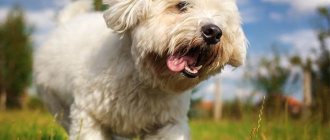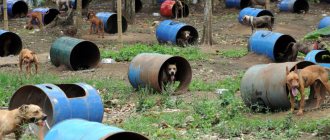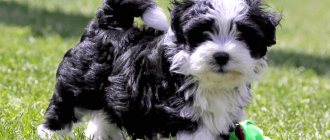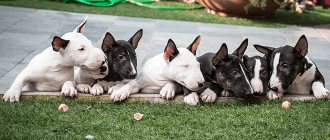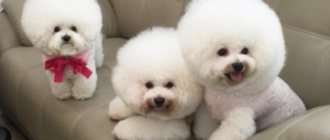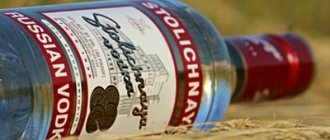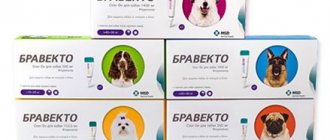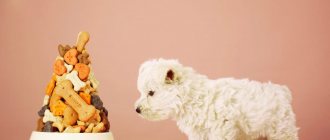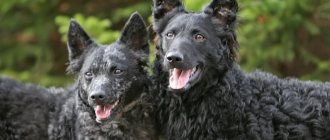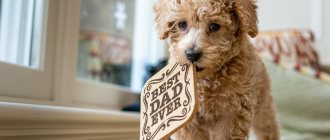Breed characteristics
| Short description | |
| Origin: | Madagascar |
| Conditions of detention: | House, apartment (room) |
| Purpose: | Decorative dog, companion |
| Color: | White with smoke spots (or plain) |
| Wool length: | Long |
| Adult dog size: | The height of the female is 23-25 cm, the male is 26-28 cm; male weight – 4-6 kg, female – 3.5-5 kg |
| Average life expectancy: | 14-19 years old |
| Walk: | Walking twice a day is recommended |
| Physical activity needs: | Average physical activity needs (40-minute walks recommended) |
| Fédération Cynologique Internationale (FIC) classification: | Group 9: Toy and companion dogs; Section 1: Bichons and related breeds |
| Puppy price: | 35000-45000 rubles. Without pedigree – 35,000-38,000 rubles, pet class – 40,000 rubles, breed class – 42,000-43,000 rubles, show class – 45,000 rubles |
What can your pet get sick with?
Despite its fragile appearance, the Coton de Tulear has good health. Average life expectancy is 14–16 years. This breed has no genetic diseases, but like most small dogs, the Coton de Tulear can suffer from:
- Progressive retinal atrophy is a vision disorder caused by the loss of photoreceptors in the inner wall of the eye. Leads to complete blindness. To date, there are no medications or treatments for the disease.
- Dislocation of the knee joint (dysplasia) is a disease in which the patella, consisting of three parts (thigh, patella and tibia), is in an incorrect position. The disease does not manifest itself from birth, but throughout life in the form of lameness or abnormal gait. An improperly formed joint or one damaged as a result of injury with constant contact “erases” the cartilage tissue, causing pain. The destruction process then affects the bone. This pathology prevents the pet from leading an active lifestyle. If the disease is detected in the early stages of its development, it is possible to stop the destruction process, otherwise the dog will remain disabled.
Dysplasia can cause pet disability
History of the origin of the species
This is one of the most ancient decorative breeds, a descendant of the French Lapdogs. There are many legends around dogs, but one thing in history is clear for sure - the birthplace of the breed is the island of Madagascar . There animals are considered a national treasure. They are loved and valued for their dexterity, agility, extraordinary mental abilities and even some cunning.
There is a legend that several little Cotons decided to swim across the river with crocodiles. To distract predators, they barked loudly in one direction and ran in another. So the dogs came to the strait, where there were no predators, and successfully crossed to the other side.
It is believed that Bolonki came to the island along with sailors and wealthy citizens of France around the 17th century. Legends were also made about this. The story tells of a strong storm and a shipwreck near the port of Tulear, after which several dogs survived and swam to Madagascar. Then the native island dogs and the white-haired European Bolonki naturally crossed, giving birth to a new breed - the Coton de Tulear. The second part of the name is the geographical place of origin. The first one is translated as “cotton”, which well describes the softness of animal hair.
For a long time, pets served as rat catchers in the holds of African ships, until they attracted the attention of aristocrats from Europe. Since then, the breed has received the unspoken name “Kings of Africa” and spread throughout European countries in 1977. At the same time, the dogs were accepted by world canine organizations and received their own standard.
Métis
There are crosses between Bichon Frize and Poodles, as well as other types of lapdogs. Such dogs take genes from two parents, but are not purebred, so they do not meet the standards of their breed.
Buying a Bichon Frize puppy in Russia is not difficult. There are many nurseries that breed this breed, as well as many private breeders. The price of a puppy is influenced primarily by its pedigree and the age of the puppy. Three-month-old puppies, for example, are more expensive than older ones.
The breeder from whom the dog is purchased must answer all the buyer’s questions clearly and clearly, and must also show the puppy’s entire pedigree, veterinary passport, where all vaccinations are prescribed. This is necessary for further purebred breeding.
Knowing heredity, namely what the ancestors of the puppy’s parents were like and what qualities they passed on to their offspring, is necessary for the further development of the breed for the desired purposes.
When buying a Bichon Frize puppy, you should first of all look at the parents in order to avoid purchasing a puppy with dental defects or non-standard characteristics. You also need to see the puppy’s parents (at least the mother) in order to have an idea of its character and further development in general.
Distinctive features
This breed is considered very rare among breeders. More often, however, Maltese and French lapdogs are found. But recently interest in Cotons has increased. Clubs are trying to breed clown dogs all over the world.
They are small in size, up to 28 cm at the withers, weigh up to 7 kg. The genotype is weakly expressed: girls and boys are similar in appearance. A distinctive feature is fluffy long white fur with or without characteristic wide ash spots.
- The head is short, when viewed from above it forms a wedge (triangular shape), the skull is not convex, flat, the occipital and frontal parts are outlined, the stop is deep.
- The muzzle is approximately equal in length to the skull, the bridge of the nose is straight. The jaw is strong, the set of teeth is complete (42), the bite is scissor, the lips are thin.
- The nose is small and black.
- The eyes are round, set deep, wide, at stop level. The color of the iris is dark.
- The ears are set high and wide, hanging down on cartilage, thin, of medium length, close to the cheekbones. The fur on the ears is long.
- The body is rectangular, well let down (squat), the top line is straight. The back is short and level, the loin is convex, the croup is sloping. The chest is wide and voluminous. The neck is short, strong, without dewlap.
- The tail is long, a continuation of the croup, and hangs below the hock. Thick at the base, tapering towards the tip.
- The limbs are short, muscular, thick. Placed parallel, straight. The toes are short, the paws are rounded. The movements are light and springy. A characteristic feature is a jump with four limbs, and not with two.
- The coat is long, wavy, fluffy, and of medium hardness.
- Color – white with smoky spots.
Where to keep the “cutie”
Despite your pet's fluffy coat, it is impossible to keep him outside. The Madagascar Bichon is afraid of cold weather, and its small size seems to hint at keeping the animal in a house or apartment. Naturally, the dog should have its own place where it will sleep and eat.
It is also not recommended to keep a Hungarian Vizsla, Shar Pei, Estonian Hound, Biewer Yorkie, or Chihuahua outside.
If you have a private house with a large fenced area, then your pet will be extremely happy with frequent and long walks.
Photo of an adult dog
Photos of puppies
Features of character and behavior
This breed is considered ideal for serving as a companion.
Such a dog can become a friend to any family member: in different age and social categories. Coton will get along well with children, will not bother an elderly person with games, but will cheer up.
The animals are perky, cheerful and playful, but can remain calm while waiting for the owner's attention. They are devoted to their family, have a strong protective instinct, but never show aggression.
Advantages
The advantages of the breed include:
- Perky character, playfulness, activity;
- Sensitivity to the family, a sense of proportion, unobtrusiveness, the ability to adapt to the lifestyle and mood of the owner;
- Good mental abilities, learning ability;
- Responsiveness;
- Love for children, loyal attitude towards rodents, cats and fellow creatures;
- Pronounced protective instinct, hunting abilities.
Flaws
Cotons are positive dogs, whose shortcomings do not seem like disadvantages to everyone. In fact, owners do not notice characteristic behavior problems, because they love the pranks of their pets. But the character of almost all representatives of the breed contains the following traits:
- Cunning, enterprise (even if Coton knows that he is guilty, he will always find a way to dodge punishment);
- Loud voice and frequent barking for no reason;
- Intolerance of loneliness;
- Increased need for attention (animals love to find the highest vantage point, table or cabinet, and persistently demand the attention of the owner or guests).
Care and maintenance
The owners of Cotons are sure that they do not know any smarter and more cunning than these dogs. Indeed, animals have serious mental abilities, so it is important for them to organize intellectual training. Also, all Bichons need training and education. A lot of time and attention will have to be paid to your pet’s fur to keep it in a beautiful, well-groomed form. In all other respects, dogs are unpretentious.
It is better to keep them in an apartment or house. On the street, Cotons get dirty quickly. They are also not recommended to put stress on their back and limbs. Before buying a puppy, you need to take care of a separate corner for sleeping (buy a lounger), for feeding (bowls on stands), games, a temporary toilet or a stationary tray.
Nutrition
Dogs are not prone to allergic reactions and dermatitis, but they quickly gain weight (especially with low physical activity). On average, an adult Coton needs 400-800 grams of food per day. The volume is divided into two doses. Babies are fed more often:
- Up to 3 months – 5-6 times;
- Up to 5 – 3-4 times;
- Up to 8 – 3 times.
The serving size depends on the time of year (more food is needed in winter), the weight of the animal, its appetite and activity.
The owner has a choice: natural or dry food. Now breeders more often choose the second option. It is more economical and practical. The granules are ready for use and contain the entire complex of vitamins and minerals. In addition, you can choose food based on the dog’s personal criteria: weight, size, age, activity, illness or temporary condition (pregnancy).
We recommend that you read a detailed article on the topic: “How and what to feed a dog: types and characteristics of nutrition.”
Cotons will benefit from super-premium food for light-haired, inactive small animals. It is advised to take a closer look at holistic (grain-free) or Human Grade products.
Natural nutrition is still considered healthy and balanced, provided that the menu is properly designed. A mandatory component is protein (40-50% of the menu) . This can be lean lamb, rabbit, turkey, eggs (no more than 2 times a week), sea fish, dairy products. Carbohydrates – buckwheat, rice, oatmeal – 30-40% of the diet (boiled). The dog also needs fresh vegetables and fruits, fats (vegetable oils, fish oil).
It is forbidden to feed the dog from the table; the pet must know its regime. Dogs should not eat flour, sweets, fatty, smoked, or salty foods. Bread, butter, pork, chocolate, milk (for adults), onions and garlic, and citrus fruits are excluded from the menu.
Also taboo on sausages. Legumes, potatoes, cabbage, and melon are not recommended. Contrary to myths, animals do not need bones; consuming them is dangerous for digestion and even the life of the pet.
Health
Due to the meager gene pool (after all, the breed was formed independently, without additional selection), dogs are prone to some hereditary diseases. But statistics show that approximately 1 in 100 puppies are predisposed to some kind of genetic problem. Cotons live 14-19 years, they are accustomed to physical activity, climate change and work.
Vaccinations
Some owners believe that decorative dogs can live without walks, and therefore without vaccination. But even a pet that sits at home can catch the infection from a person. The owner brings thousands of bacteria and germs on shoes, clothes, hands. Therefore, even couch dogs need to be vaccinated.
- Vaccination of dogs begins at 2 months, when the mother’s immunity ceases to protect the puppy (after weaning). At this time, children are especially vulnerable to the threat of infection. Typically, the first injection is given at the nursery. It includes strains of plague, influenza, parvovirus enteritis, hepatitis, and leptospirosis.
- One vaccination is not enough for comprehensive protection, especially in the first year of a dog’s life. Therefore, vaccination is repeated after 2 weeks, at 6 and 12 months. Then an annual revaccination is needed, for which the owner is responsible.
- The second important drug forms immunity against rabies. It is administered at 7 months and repeated annually. In some cases, revaccination is allowed after 2-3 years .
Before the procedure, 2 weeks before, deworming (cleansing of worms) is carried out.
On the day of vaccination, the pet must be completely healthy, so the dog’s body temperature must be measured at the clinic. It is recommended that vaccinations be done in a veterinary hospital so that the doctor can respond to an unexpected allergic reaction.
A special veterinary passport is created for the pet, in which all vaccinations will be noted, and labels from the drugs with which the dog was vaccinated are also pasted in. This is important for subsequent treatment or transportation of the dog across the border. An animal will not be allowed into the country if it lacks two basic vaccinations (vaccination is allowed no earlier than 1 year before travel and no later than 24 days before transportation).
Important article on the topic: “Everything you need to know about dog vaccinations.”
Diseases
Diseases characteristic of representatives of the breed:
- Cataract, glaucoma;
- Liver diseases (cirrhosis, gall bladder problems);
- Urolithiasis disease;
- Problems with the cardiovascular system;
- Skin fungal diseases;
- Sprained ligaments, displacement of the joints of the spine.
Walk
Despite the awarded status of a decorative breed, the Coton de Tulear is accustomed to traveling and working. Therefore, staying at home is harmful for them. Although some dogs get used to such a life and do not want to walk outside, they use a home litter box. It is recommended to walk your pets 2 times a day for 40 minutes.
Puppies up to 3 months of age are carried out in arms; dogs cannot be put on the ground until the 2nd vaccination . To avoid excessive stress on the back and joints, children are not allowed to go up and down stairs or jump on their hind legs. Up to six months, dogs are taken out 3-4 times for 20 minutes , and by the year they are accustomed to the regime.
In the process of walking, the pet's character is formed; this is called socialization. From childhood, the animal is accustomed to noisy places, unfamiliar people and other dogs. This will help eliminate traits such as cowardice and aggressiveness in an adult dog.
Grooming
The breed does not shed, which adds another positive feature to them - hypoallergenicity . Therefore, dogs need to be brushed regularly (daily) with a brush with long metal teeth. For exhibition, a natural long coat without coloring is required. But for convenience, domestic dogs are cut once every six months (or more often). It is also used to whiten the fur around the eyes and between the toes. These dogs are characterized by their hair being colored brown or reddish due to natural secretions, which spoils their appearance.
They bathe dogs every 2-3 weeks , using natural shampoos for dogs with white hair; after walks, be sure to wash their paws and face (as well as after eating). Drying is necessary so that the baby does not catch a cold (minimum temperature of the hair dryer and a distance of at least 20 cm). The ears are examined and cleaned after bathing. Eyes are washed once a week. Claws are trimmed as they grow.
In the summer, systematic regular treatment against ectoparasites will be required. Every 3 months, pets undergo a deworming procedure. In winter, protective clothing is needed.
Nutrition
Representatives of the African breed are practically unpretentious in nutrition. They can be fed natural and dry food. In both cases, special attention must be paid to the quality and preparation of a balanced diet. You will need to include in your feeding program:
- lean meats;
- vegetables;
- porridge;
- fruits;
- greenery;
- dairy products;
- mineral and vitamin supplements;
- offal.
Such a balanced diet will fill the animal’s body with all the necessary components and replenish lost energy.
Premium dry dog food
Rating
Holistic dog food
Rating
Small breed dog food
Rating
Mating
Only sexually mature individuals who have reached 2-2.5 years can be knitted . At this time, the girls should already be in their third heat. The first begins at about 8 months. Typically, females breed 2 times a year, sometimes less often. The owner should mark the beginning and end of the cycle in order to know the dates of possible mating and pregnancy.
Read a detailed article on the topic: “Everything you need to know about breeding dogs: appropriate age, what to do if it doesn’t work out, rules and tips.”
In the first days of the new cycle (from the beginning of estrus), the owner turns to the club to select a good male who would complement the girl’s shortcomings. The owners sign documents, certificates, and set a date. Days 13-15 of the cycle are considered the best . They are indicated by symptoms: loose loop, playful behavior, light discharge. The female may behave unnaturally, not respond to commands, play around or become depressed. This is normal due to hormonal changes.
On the appointed day, the animals are brought together in the male territory (or in a neutral area). It is better to walk your pets in advance or give them time to get to know each other. Females sense when to allow the male to mount. Due to their non-standard physique, Cotons are difficult to resist, so they will need help from their owners. The girl is held by the head and under the belly, the male is held by the lower back, guiding him into the noose.
After active tremors, the pets freeze in the lock, where they need to be held for 5-7 minutes . Even in the absence of a castle, the female can become pregnant. The fixative mating is carried out after 2 days .
Pregnancy can be tracked at a veterinary clinic and confirmed by ultrasound (only shows from the 3rd week). It is important to monitor changes in the girl’s behavior so that if any negative symptoms occur, contact the clinic. There is a risk of false pregnancy or pyometra.
Key points in training
Despite the fact that Cotons are decorative, they need to be trained and educated from childhood. Puppies are taught the rules of behavior in the house. This breed trains well, accepts all instructions from its owners, and listens to members of the household. Therefore, problems with education do not arise if it is structured competently and in a timely manner. From the age of 2 months, the pet is told what is possible and what is not; They are forbidden to sleep in bed with the owner and chew human things.
It is prohibited to use harsh methods of punishment or brute force. To show a dog that it is wrong, all it takes is a stern tone, a look, or deprivation of a treat or toy. The best teaching method remains motivational - stimulation with goodies.
These dogs are often called circus dogs or clowns; they really do all the tricks easily. Not all Cotons are taught to carry out any special commands, but any dog needs to know the basic signals: “sit”, “lie down”, “place”, “no”, “voice”, “near”. By 3-4 months, the puppy should know its name .
Read about how to properly train a dog in the article: “Training a puppy: effective methods from dog handlers, learning commands at home.”
You can resort to the help of a kennel club or conduct group training with other dogs. This way the pet can learn from the example of others and socialize.
Which one is better to choose?
When choosing a decorative dog, the buyer's choice often falls on Bichons. If the potential buyer has children, this is the most suitable dog. But which Bichon breed is best?
For active recreation in nature with a dog and its training, any Bichons, except Maltese, are suitable.
The most prone to training is the Bichon Frize. Also, thanks to its rather large build, the Bichon Frize can play with children without harm to its health.
Dogs that perfectly meet the standards are sent to exhibitions, so if a dog will participate in exhibitions, then it must be purchased with all documents and vaccinations, of course, without defects in body structure and coat color.
